
The Bottom Line
Introduction and Quick Specs
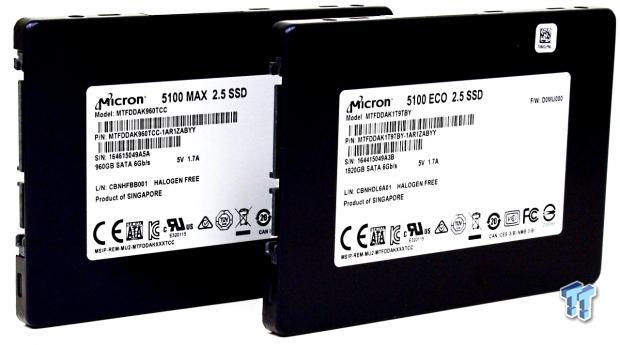
Today's datacenter is being overwhelmed by large quantities of data. Traditional spinning media cannot keep up with this data deluge. Spinning media is no longer cost effective or powerful enough to keep up with the IO demand generated in the modern era. The enormous physical footprint required for spinning media capable of generating the IOs required by today's demanding workloads is by itself enough to assure its extinction in the near future.
The time is now to revolutionize the datacenter with flash, because as Micron's mantra "Spinning Media Is Winding Down" suggests, spinning media is well on its way to the dustbin of history. This mantra is a statement of fact, and Micron stands ready to deliver the all-flash solutions required for an efficient, modern datacenter.
In the datacenter, TCO (Total Cost of Ownership) is without question the most important procurement consideration. Flash-based storage, while initially more expensive, is so much more powerful, reliable and efficient than spinning media that it is easy to see why the days are numbered for mechanical storage. A simple TCO comparison illustrates this fact perfectly:
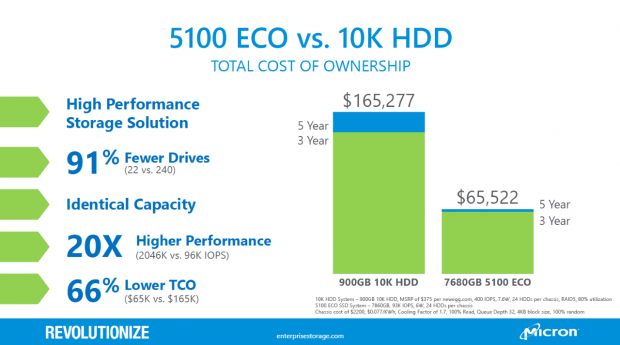
As the above graphic illustrates, in an all-random read environment, a 22-drive Micron 5100 ECO array outperforms a 240-drive 10K HDD array by 20X with 91% fewer drives. Additionally, over the span of five years, the 5100 ECO array has a 66% lower TCO than a 240-drive 10K HDD array. In this scenario, matching the IO performance of a 22-drive ECO array utilizing spinning media would require 4,800 10K HDD's. When you take into consideration the physical footprint, additional hardware, and power required to operate 4,800 HDDs, the advantages of an all-flash array become crystal clear.
Micron's 5100 series SSDs are available in three models (ECO, PRO, and MAX) and two form-factors; 2.5" cased and M.2 2280. The 5100 ECO is designed for read-intensive applications. The 5100 PRO is designed for latency-sensitive database applications. The 5100 MAX is designed for write-intensive applications.
Micron lists the key benefits of their 5100 Series SSDs as follows:
- High Capacity: Consolidate storage platforms and smooth migration from legacy storage. The 5100's ability to offer up to 8TB of storage in a 2.5-inch form factor and 2TB in an M.2 provides a wide range of solutions.
- Consistent High Performance: Meet the demands of your data center. The 5100 comes in three models optimized for varying workloads with consistent, steady state random writes at up to 74,000 IOPS.
- Comprehensive Security: Alleviate enterprise security concerns with built-in AES-256-bit encryption and TCG Enterprise protection with available FIPS 140-2 validation.
- Ultimate Flexibility: Actively tune capacity to optimize drive performance and endurance with Micron's FlexPro™ firmware architecture.
- Outstanding Reliability: Reduce downtime and latency with 99.999% quality of service (QoS) that is unmatched compared to spinning media.
Looking at the 5100 Series feature set, there are two things that jump out at us right away:
1) Tunable capacity at the hardware level.
2) Up to 74,000 4K random write IOPS in a steady-state.
The ability to actively tune capacity at the hardware level via Micron's FlexPro architecture means that the ECO or Pro can effectively be repurposed to deliver write performance and endurance equivalent to the MAX or anything in between. It is even possible to increase the endurance of the MAX if desired. Micron calls this feature FlexCap. The FlexCap feature is part of Micron's newest version of their Storage Executive SSD software. We will demonstrate the versatility that FlexCap brings to the table further on in this review.
At up to 74,000 4K random write IOPS in a steady-state, the 5100 MAX is reaching a level of random write performance never before seen from a SATA SSD. What makes this even more incredible is fact that this level of random write performance is coming from a 3-bit (TLC) flash array. The key to the incredible random write performance delivered by the PRO and MAX models is a large to massive dose of over-provisioning. Here is a breakdown and explanation of the factory overprovisioning implemented on the 5100 Series as given by Micron:
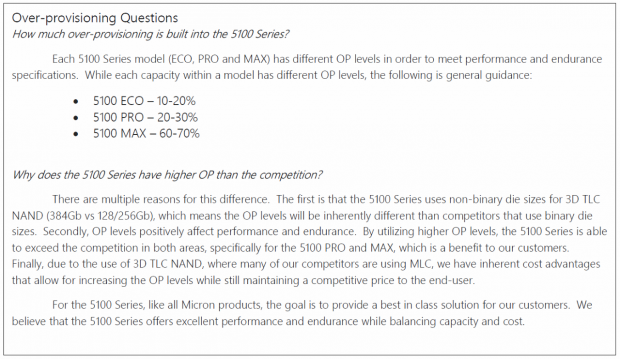
Micron is able to fortify their enterprise SSDs with the most OP of any manufacturer for two reasons. Number one they own the NAND flash fab. Number two is the fact that Micron flash is more cost effective than others. When it comes to steady-state performance, the more over-provisioning allocated at the hardware level, the better the drive will perform when writing random data.
To this point, Micron has three lines of 3D TLC SSDs in their portfolio. On the consumer side, Crucial's highly successful MX300. On the OEM or client side, the Micron 1100 series and now on the enterprise side the Micron 5100 series. All three are similar to one another; all three are utilizing Micron's first generation 384Gb, 32-layer 3D TLC flash, and Marvell's versatile fifth-generation 88SS1074 four-channel SSD controller. Marvell controllers are provided without firmware. This requires buyers of Marvell controllers to create customized in-house firmware for the controller, which is the reason you will not find Marvell controlled SSDs coming from smaller vendors.
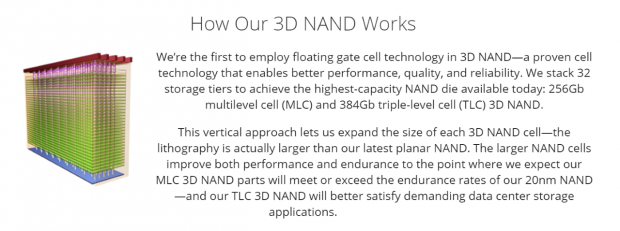
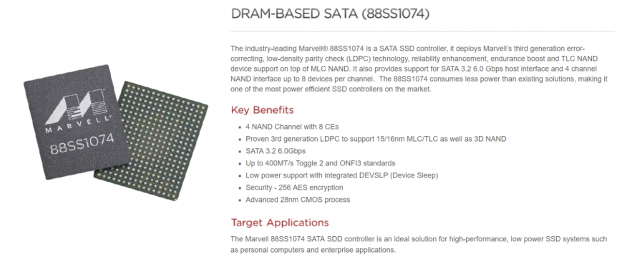
The Crucial MX300 and Micron 1100 series employ consumer-grade 3D TLC NAND flash; the Micron 5100 Series utilizes enterprise-grade 3D TLC, or 3D eTLC NAND flash providing better performance and endurance. Further differentiating the 5100 from consumer versions is the absence of an SLC caching layer to mask write performance. In a steady-state environment, SLC caching hurts overall performance. Additionally, the 5100 series has onboard host power-loss protection.
We are anxious to see for ourselves if the 5100 MAX can deliver an earth-shattering 74,000 4K random write IOPS in a steady-state, so let's dive in and find out.
Quick Specs
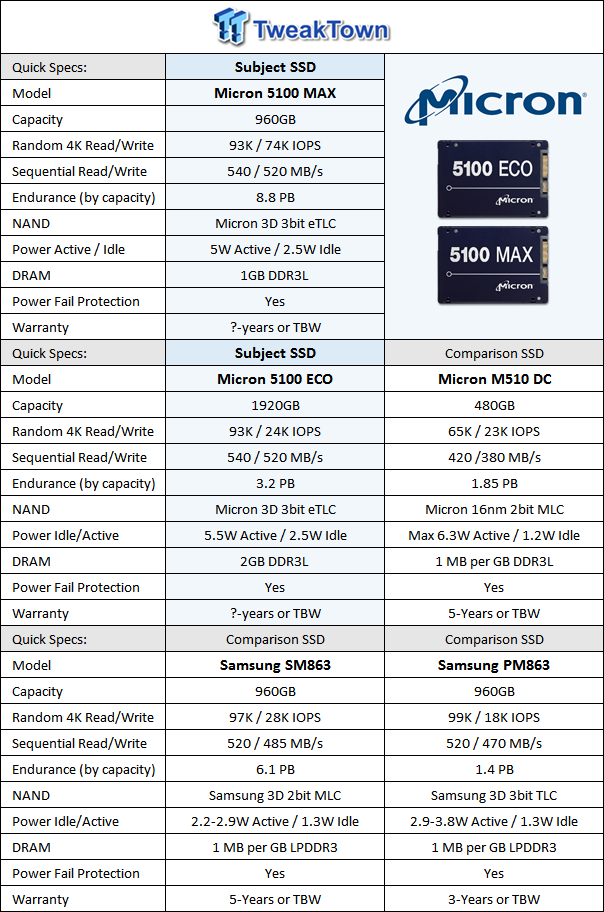
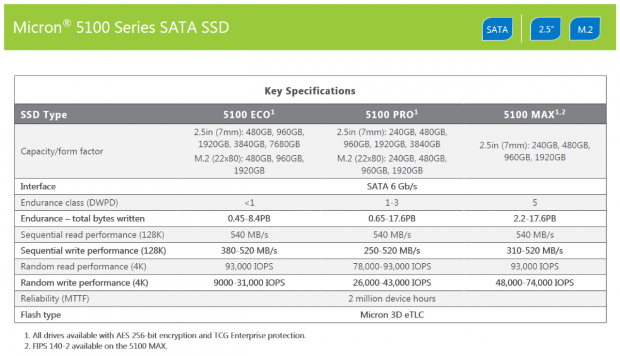
The Micron 5100 ECO 1920GB SATA III SSD we have on the bench today sports the following hardware and steady-state performance specifications:
4K Random Read/Write = 93K/24K. Sequential Read/Write = 540/520 MB/s. Power consumption = 5W Active/2.5W idle. Controller = Marvell 88SS1074 four-channel. NAND = Micron 3D 3bit eTLC. Data DRAM Cache = 2GB. Onboard Host Power-loss Protection = Yes. Warranty = 3.2 PBW or as specified by your Micron Representative.
The Micron 5100 MAX 960GB SATA III SSD we have on the bench today sports the following hardware and steady-state performance specifications:
4K Random Read/Write = 93K/74K. Sequential Read/Write = 540/520 MB/s. Power consumption = 5W Active/2.5W idle. Controller = Marvell 88SS1074 four-channel. NAND = Micron 3D 3bit eTLC. Data DRAM Cache = 1GB. Onboard Host Power-loss Protection = Yes. Warranty = 8.8 PBW or as specified by your Micron Representative.
Micron 5100 ECO/MAX SATA III SSD - Photos and Full Specs
Photos

The top of the drive's midnight blue colored aluminum enclosure features a manufacturer label.
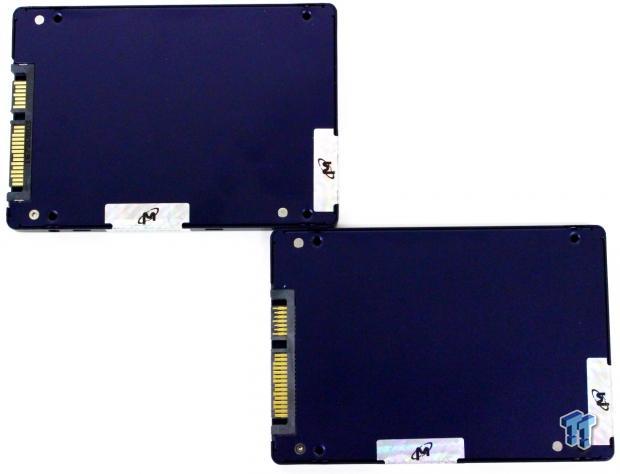
The bottom of the drive's aluminum enclosure is bare except for two tamper evident stickers.
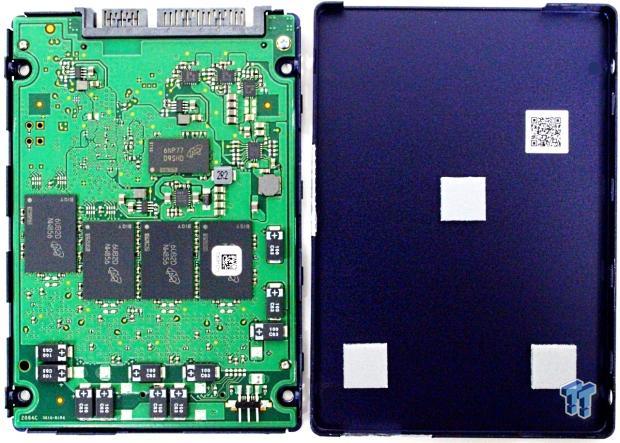
The PCB is held in place by one screw and two locator pins. Three foam spacers are affixed to the underside of the top of the enclosure. On this side of the PCB, both the ECO and MAX are identical.
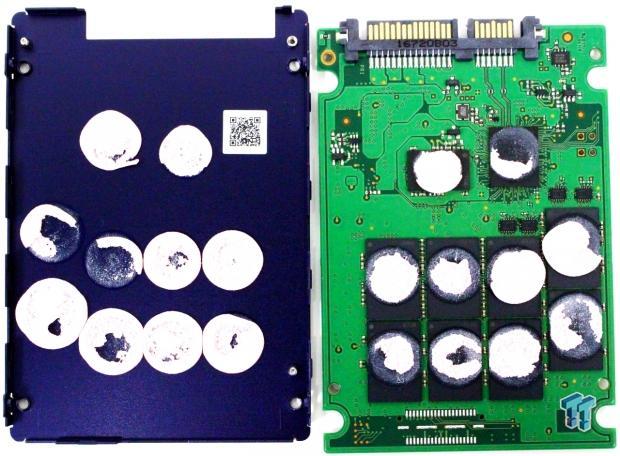
We removed the 5100 ECO's PCB from the bottom of the enclosure, and it did not come apart cleanly. The thermal paste used is sufficient for thermal conduction, but difficult to remove. We decided against scraping it off to get a better look. We also decided against removing the 5100 MAX's PCB as it could negatively impact the thermal material.

Micron provided architectural details of the major components for both drives.
Specifications and Features

Pricing: Micron's 5100 ECO 1920GB retails for approximately 45 cents per gigabyte.
Pricing: Micron's 5100 MAX 960GB retails for approximately 59 cents per gigabyte.
Test System Setup, Testing Methodology & FlexCap
Jon's Enterprise SSD Review Test System Specifications
- Motherboard: ASRock Rack EPC612D8A-TB (Intel C612 chipset) - Buy from Amazon
- CPU: Intel Xeon E5-2699 V3 18 Core 36 Thread - Buy from Amazon
- Cooler: Supermicro Air Cooling
- Memory: 64GB Samsung DDR4 ECC 2133MHz - Buy from Amazon
- Video Card: Onboard Video
- Power Supply: Seasonic Platinum 1000 Watt - Buy from Amazon
- OS: Microsoft Windows Server 2012 R2 64 Bit - Buy from Amazon
- Drivers: Intel Proprietary NVMe driver
We would like to thank ASRock Rack, Crucial, Intel, Samsung, Seagate, and Seasonic for making our test system possible.
TweakTown's Enterprise SSD testing methodology replicates typical enterprise workload environments as closely as possible. Our test systems employ enterprise based hardware. Enterprise chipsets, Intel Xeon processors, ECC DRAM, and standard air-cooling. Storage drivers are Windows standard drivers, except as otherwise required for the test device to operate as designed.
TweakTown strictly adheres to industry-accepted Enterprise Solid State Storage testing procedures. Each test we perform repeats the same sequence of the following four steps:
- Secure Erase SSD
- Write entire capacity of SSD a minimum of 2x with 128KB sequential write data, seamlessly transition to next step
- Precondition SSD at maximum QD measured (QD32 for SATA, QD256 for PCIe) with the test specific workload for a sufficient amount of time to reach a constant steady-state, seamlessly transition to next step
- Run test specific workload for 5-minutes at each measured Queue Depth, record results
We chart workload preconditioning IOPS or MB/s and latency for each specific test. We plot workload preconditioning using scatter charts with each recorded 1-second data point represented on the chart, allowing us to see some of the performance variability exhibited by our test subjects. We chart workloads using line charts plotting average workload IOPS or MB/s and latency at each measured QD. Utilizing line charts provides a good visual perspective of the test subject's performance curve.
To summarize, we test with Enterprise hardware, Windows Server Operating System, and we strictly adhere to industry-accepted Enterprise SSD testing procedures. Our goal is to provide results that are consistent, reliable, and repeatable.
FlexCap
We wanted to test out Micron's new FlexCap feature that allows the user to actively tune capacity to optimize drive performance and endurance through Micron's FlexPro firmware architecture. We decided to take the 1920GB ECO and OP at the hardware level by an additional 100% by reducing user capacity to 960GB. This should result in a massive increase in write performance.
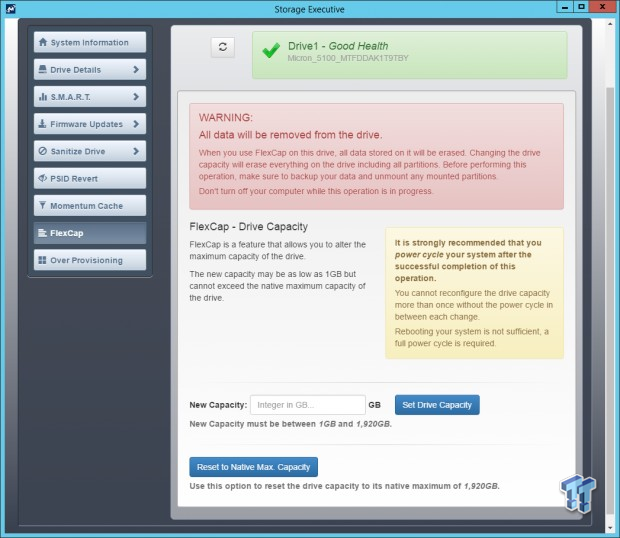
First, we download and installed the latest version of Micron's Storage Executive SSD management software. Clicking on the FlexCap tab brings up the screen shown above. We entered our new capacity as 960GB and set the drive capacity.
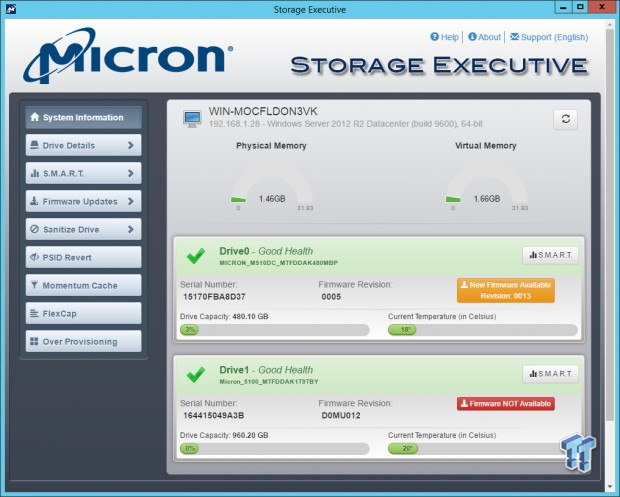
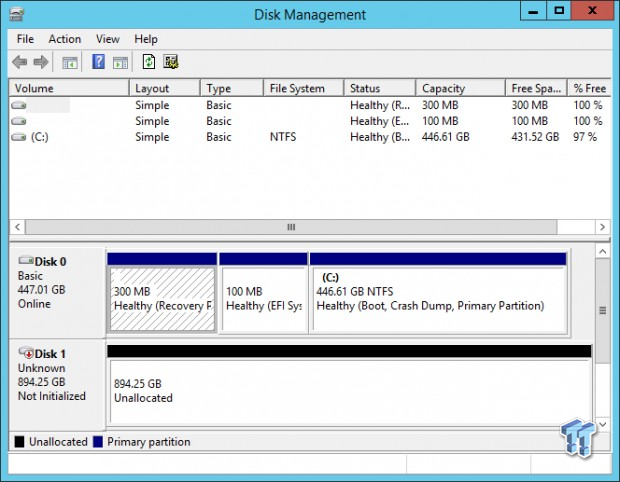
After a power-down and reboot, we checked to see that the new user capacity was set to 960GB and it was.
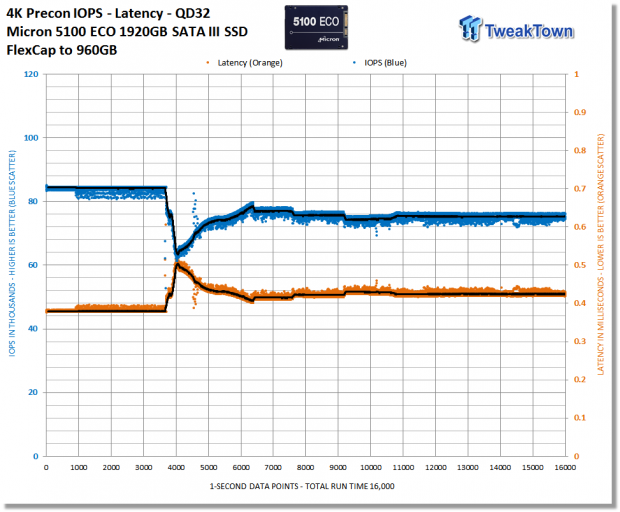
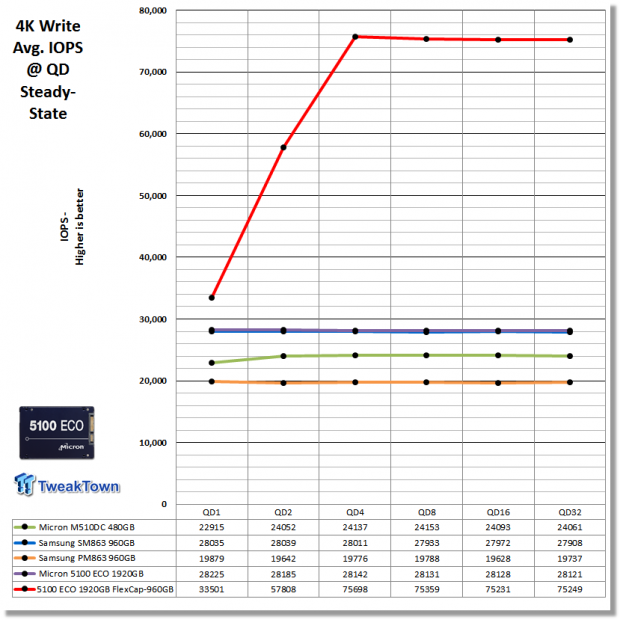
We decided to check the impact this would have on random write performance, and we were not disappointed. With the additional OP, the ECO became almost as powerful as the MAX (compare to MAX on the next page).
The only reason it didn't exceed the MAX' performance is due to the controller overhead incurred when managing a larger flash array. Nearly 3X better performance than at factory OP. Logic follows that it would have an endurance of roughly 10 PB in this configuration. As you can see with FlexCap, it is easy to tune the write performance and endurance of Micron's 5100 series SSDs.
Benchmarks - 4K Random Write/Read
4K Random Write/Read
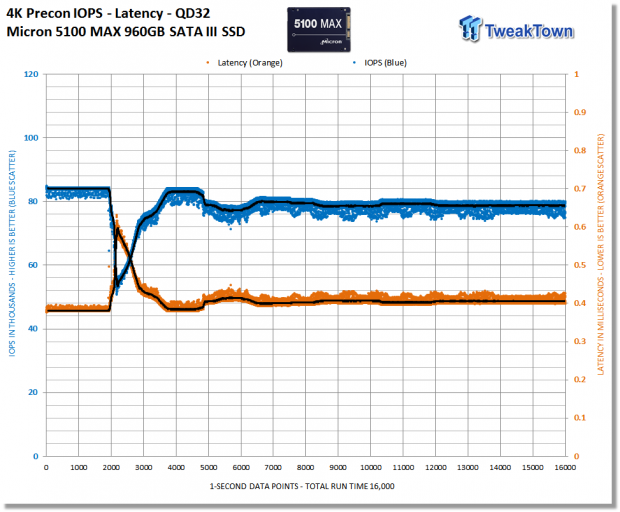
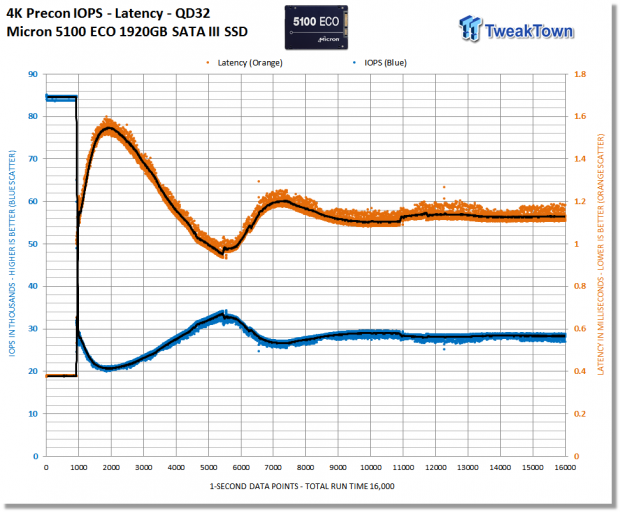
We precondition the drive for 16,000 seconds, or 4.44 hours, receiving performance data every second. We plot this data to observe the test subject's descent into steady-state. We plot both IOPS and Latency. We plot IOPS (represented by blue scatter) in thousands and Latency (represented by orange scatter) in milliseconds.
We observe steady-state for the 5100 MAX is reached at 7,000 seconds of preconditioning, where it settles in at roughly 78-79,000 IOPS. This is the first time we've witnessed an SSD almost return to FOB performance while in a steady-state. At its lowest point (54K IOPS pre-steady-state), the 5100 MAX is still delivering far better performance than we've seen from any other SATA SSD in a steady-state. The 5100 ECO hits steady-state at 11,000 seconds where it settles in at roughly 28,000 IOPS.
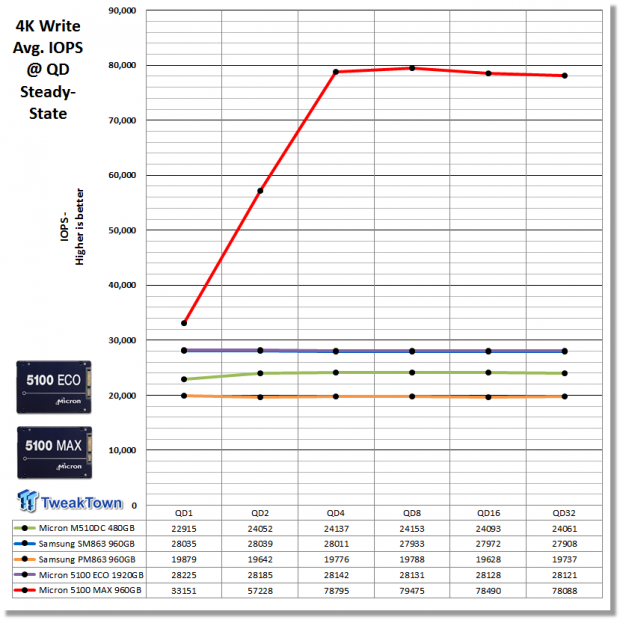
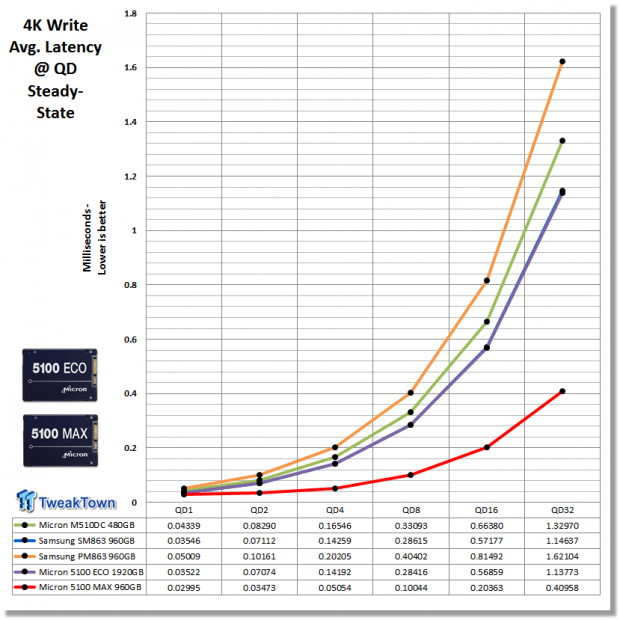
The 5100 MAX is cranking out almost 3X the performance of its nearest competitor. With our configuration, we are easily exceeding Micron's 4K random write factory specification for both the 5100 MAX and ECO. We are able to extract well over 79,000 IOPS with the 5100 MAX at QD8. Simply amazing performance from a SATA SSD. It's by-far the best 4K random write performance we've ever seen from any SATA-based SSD to date.
The 5100 ECO just edges out Samsung's MLC powered SM863 for second place, averaging over 28K IOPS at all queue depths. Both the 5100 MAX and 5100 ECO are outperforming factory specifications; the 5100 MAX by over 5,000 IOPS, the 5100 ECO by over 4,000 IOPS.
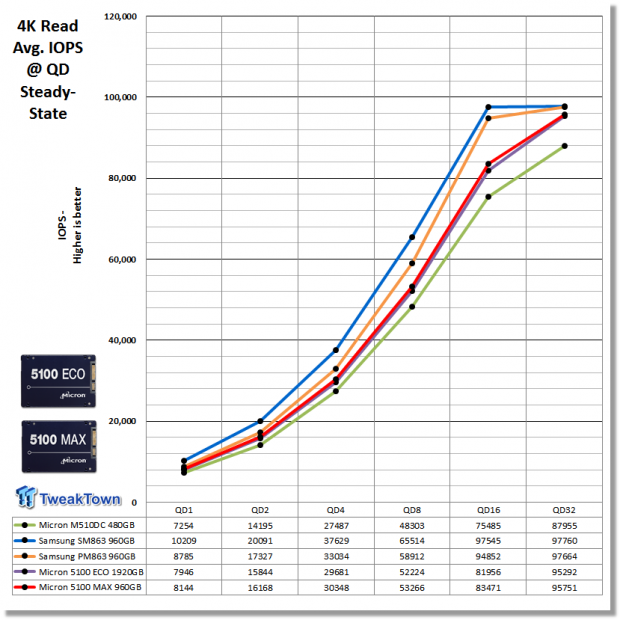
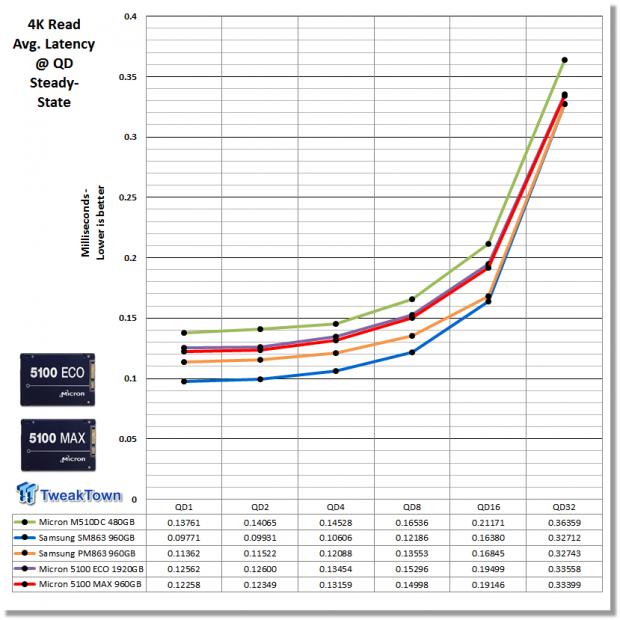
The SM863 and PM863 are read-centric SSDs, and they both outperform the 5100 MAX and 5100 ECO with a pure random read workload. At QD32, the 5100 MAX and 5100 ECO almost match the Samsung offerings. The 5100 MAX and 5100 ECO both outperform their predecessor, the MLC-powered M510DC, across the board. Micron's factory maximum 4K random read specification for both the 5100 MAX and 5100 ECO is 93,000 IOPS at QD32, we are exceeding that, hitting well over 95,000 IOPS with both drives.
Conclusion (TL;DR): The 5100 MAX and 5100 ECO both deliver best-in-class 4K random write performance. The 5100 MAX peaks at an astounding 79,475 IOPS 4K random write IOPS which is easily the best steady-state random write performance ever by any SATA SSD.
Benchmarks - 8K Random Write/Read
8K Random Write/Read
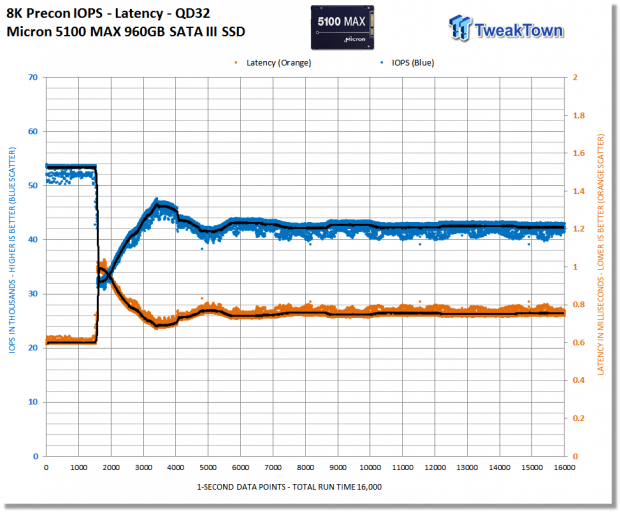
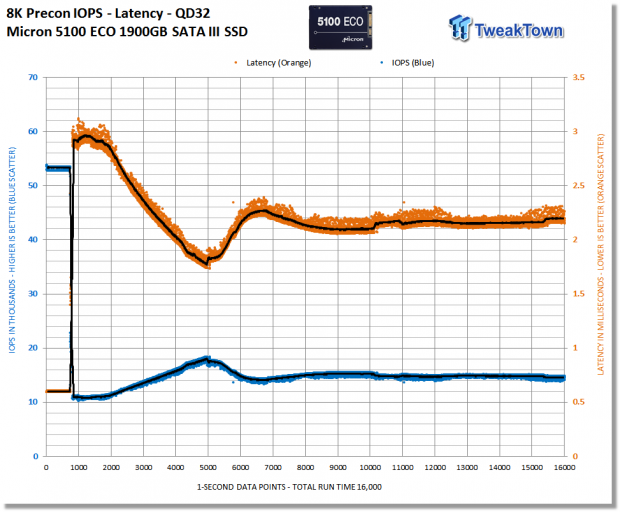
We precondition the drive for 16,000 seconds, or 4.44 hours, receiving performance data every second. We plot this data to observe the test subject's descent into steady-state. We plot both IOPS and Latency. We plot IOPS (represented by blue scatter) in thousands and Latency (represented by orange scatter) in milliseconds.
We observe steady-state for the 5100 MAX is reached at 8,000 seconds of preconditioning, settling in at about 42,000 IOPS. We observe steady-state for the 5100 ECO is reached at 11,000 seconds of preconditioning, settling in at about 14,500 IOPS.
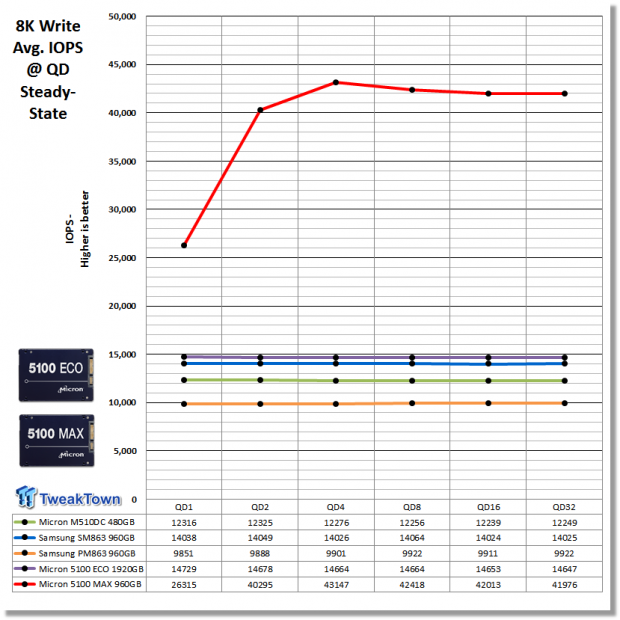
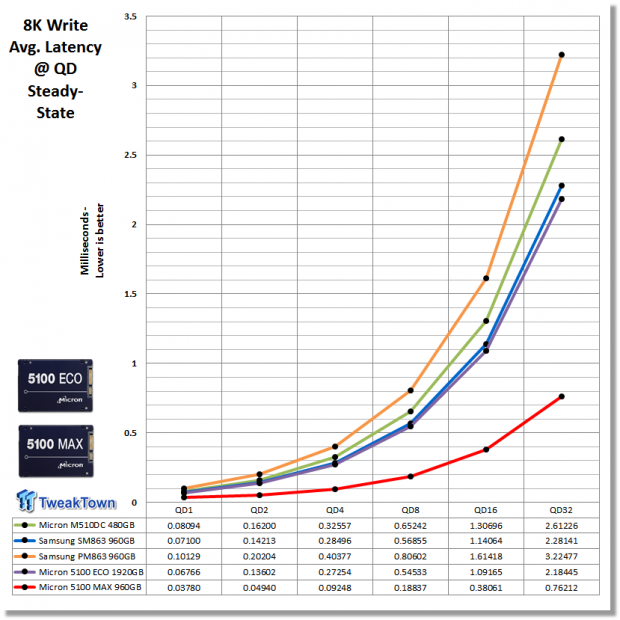
8K random is a more demanding workload than 4K random. The 5100 MAX again delivers stunning results, delivering 43,137 IOPS at QD4. The 5100 ECO delivers the second-best result, delivering 14,729 IOPS at QD1. Even the powerful MLC-based SM863 is no match for the eTLC powered Micron 5100 SSDs when writing random data. Comparing the 5100 ECO to the TLC powered PM863 reveals that the 5100 ECO delivers nearly 50% better performance.
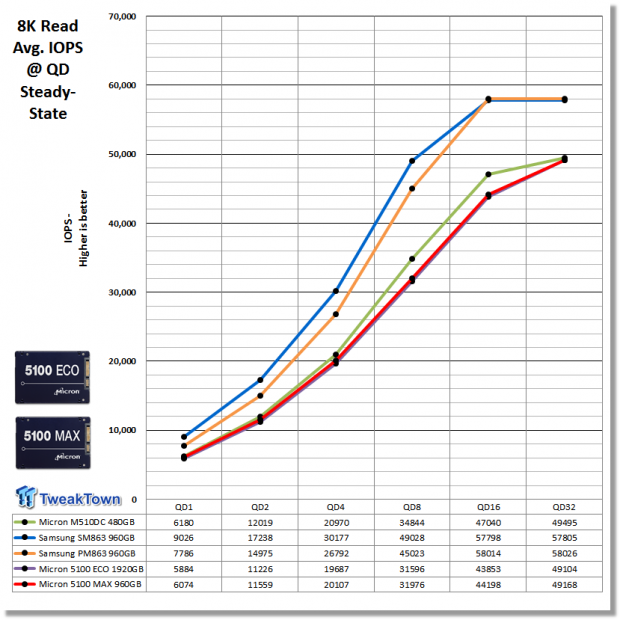

A pure 8K read workload takes its toll on the 5100 series SSDs. The Samsung offerings handily outperform both the 5100 MAX and 5100 ECO with this demanding workload. The MLC-powered M510DC manages to deliver better results than the 5100 MAX and 5100 EVO when reading 8K data. These results are testament to the write-centric nature of Micron's 5100 series SSDs.
Conclusion (TL;DR): Micron's 5100 series SSDs greatly favor write-centric workloads over read-centric workloads.
Benchmarks - 128K Sequential Write/Read
128K Sequential Write/Read
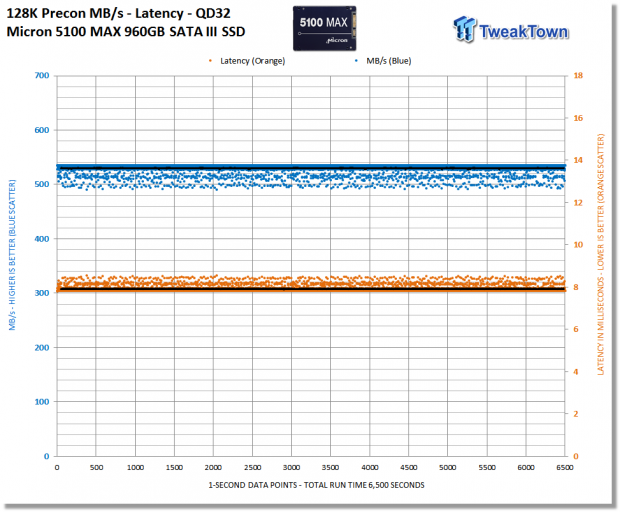
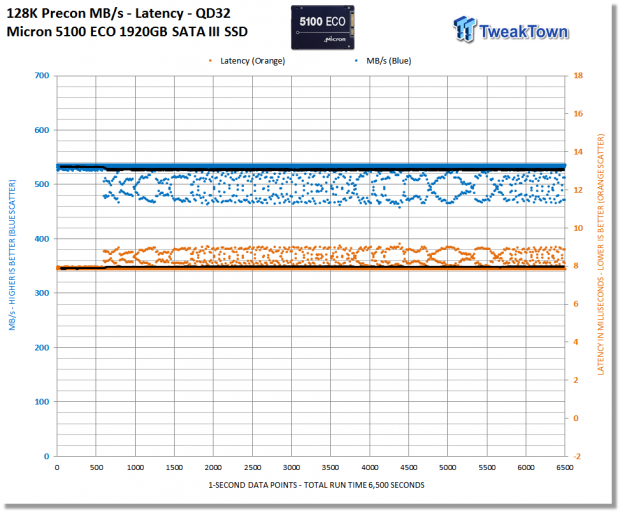
We precondition the drive for 6,500 seconds, or 1.8 hours, receiving performance data every second. A sequential steady-state is achievable in a much shorter span of time than a random steady-state. We plot both MB/s and Latency. We plot MB/s using blue scatter and Latency using orange scatter.
We observe that sequential write steady-state was induced on the 5100 MAX by the previous 2X sequential write fill as shown by its steady-state at zero seconds of preconditioning. The 5100 ECO reaches steady-state at 600 seconds into the preconditioning run. At 600 seconds into preconditioning, background garbage collection kicks in as signaled by the starting point of the turbulence in the IO pattern.
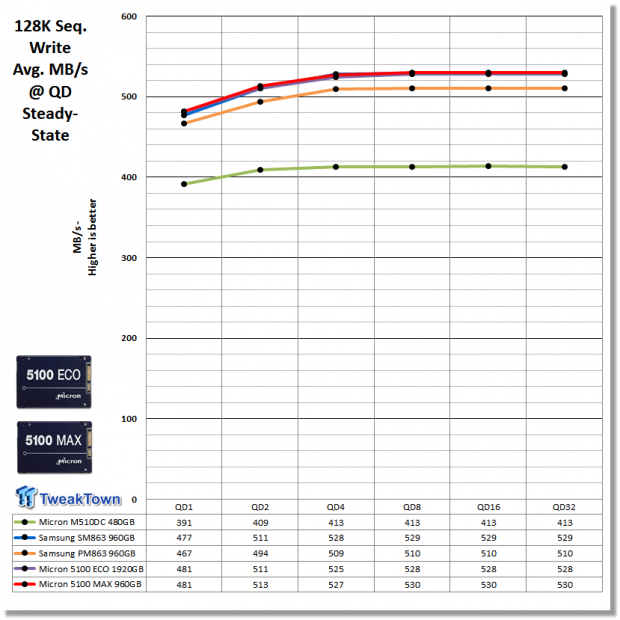
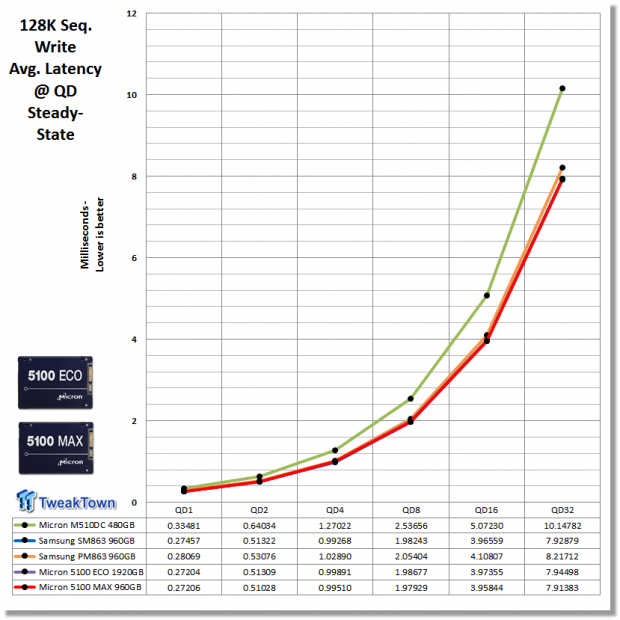
Sequential write performance is important, and this is where we see a definitive advantage for Micron's 5100 series SSDs over competing TLC-based SSDs. The 5100 series SSDs keep pace with the MLC-powered Samsung SM863, which is quite a feat for any TLC-based SSD. At QD1, the both the 5100 MAX and 5100 ECO outperform the competing drives in our test pool. The 5100 series display an improvement of roughly 25% in sequential write performance over the MLC-powered M510DC. Both the 5100 MAX and 5100 ECO are able to outperform factory specifications.
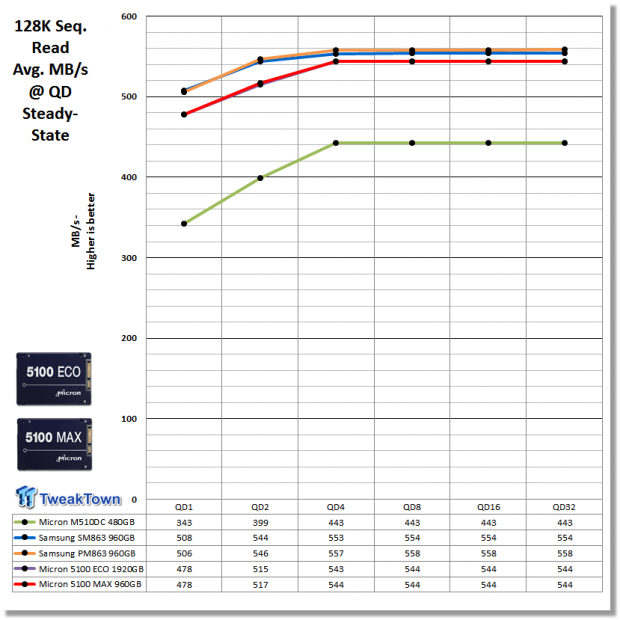
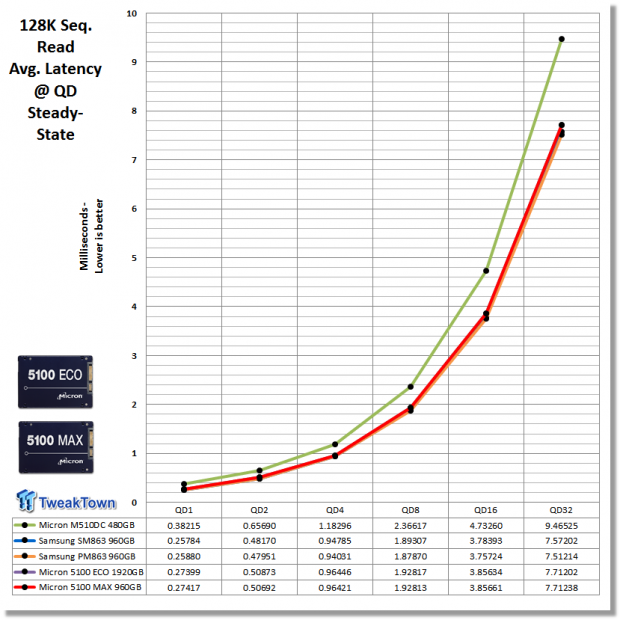
The 5100 MAX and 5100 ECO can't quite match the sequential read performance of the read-centric Samsung drives. However, the 5100 series again handily outperforms its predecessor, the M510DC by roughly 20% across the board. Once again, both the 5100 MAX and 5100 ECO perform above factory specification.
Conclusion (TL;DR): The 5100 MAX and ECO both have no issue in matching and exceeding Micron's factory sequential specifications.
Mixed Workload Benchmarks – Email Server
Email Server
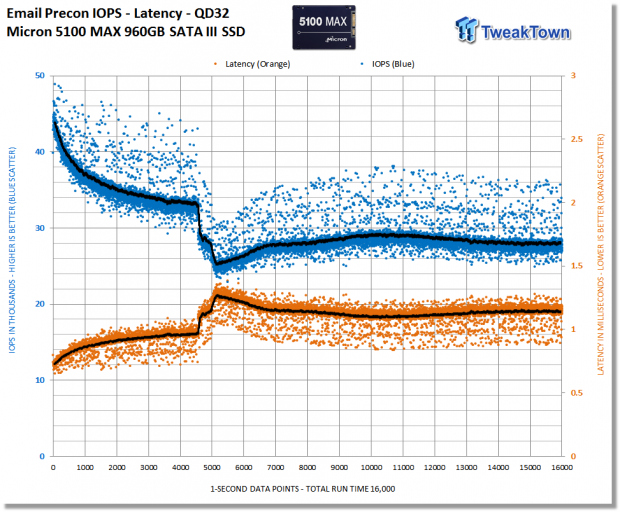
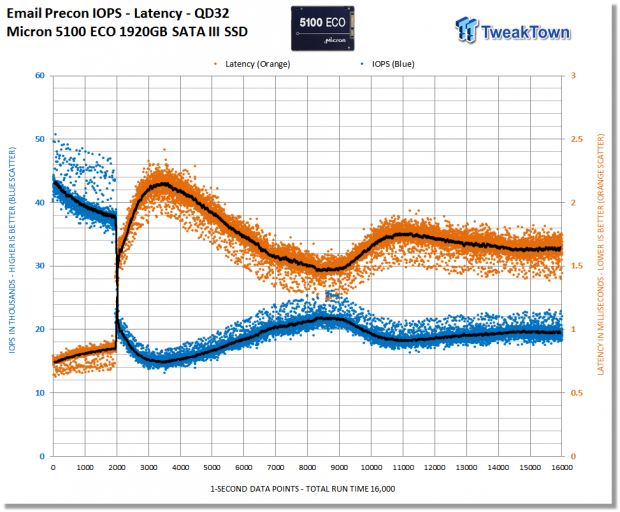
We precondition the drive for 16,000 seconds, or 4.44 hours, receiving performance data every second. We plot this data to observe the test subject's descent into steady-state. We plot both IOPS and Latency. We plot IOPS (represented by blue scatter) in thousands and Latency (represented by orange scatter) in milliseconds.
We observe steady-state for the 5100 MAX is reached at 14,000 seconds of preconditioning, settling in at about 28,000 IOPS at QD32. We note a significant number of outliers in the IO pattern. However, most of them are higher than the average, so that's a good thing. We observe steady-state for the 5100 ECO is reached at 15,000 seconds of preconditioning, settling in at about 18,500 IOPS at QD32.
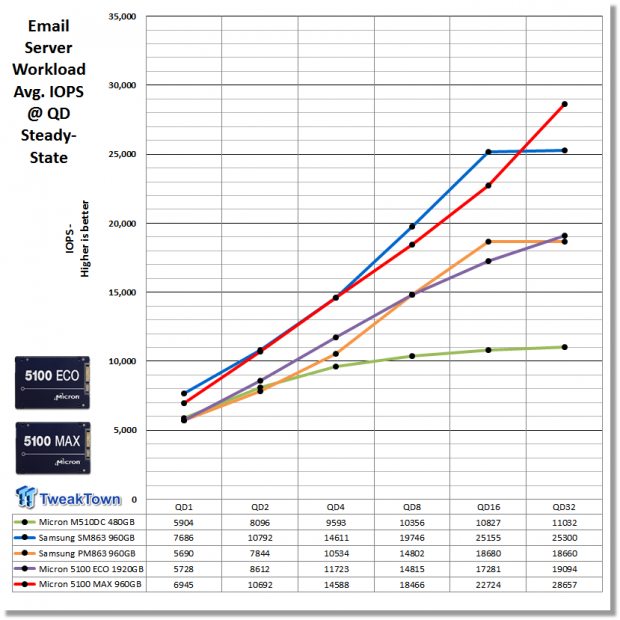
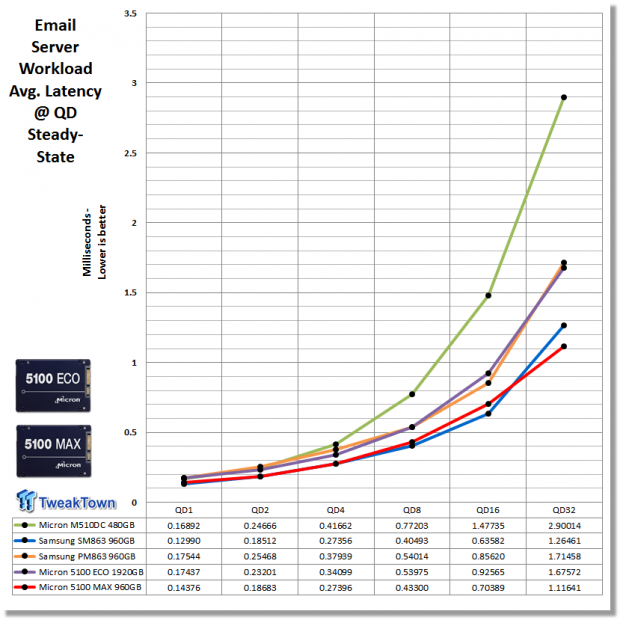
An Email Server workload is a demanding 8K test with a 50 percent R/W distribution. This application gives a good indication of how well a drive will perform in a write heavy workload environment.
Because the 5100 series SSDs are write-centric in nature, both the 5100 MAX and 5100 ECO do quite well with this write heavy workload. The 5100 ECO and the PM863 are destined to compete for market share. The 5100 ECO outperforms the PM863 at every measured queue depth except for QD16, so we will give the nod to the 5100 ECO over the PM863 when running a write heavy workload.
The 5100 MAX, for the most part, keeps pace with the SM863 up to QD4. At QD8-16, the SM863 has the advantage over the 5100 MAX. The 5100 MAX comes on strong at QD32 and flies past the SM863 by over 3,000 IOPS. Overall, we consider the 5100 MAX and the SM863 equally matched when running a workload of this nature. The M510DC doesn't perform well with this demanding workload. At QD32, the 5100 ECO shows a 9,000 IOPS improvement over the M510DC; the 5100 MAX an 18,000 IOPS improvement.
Conclusion (TL;DR): The 5100 series SSDs deliver outstanding performance in an Email Server environment.
Mixed Workload Benchmarks - OLTP/Database
OLTP/Database
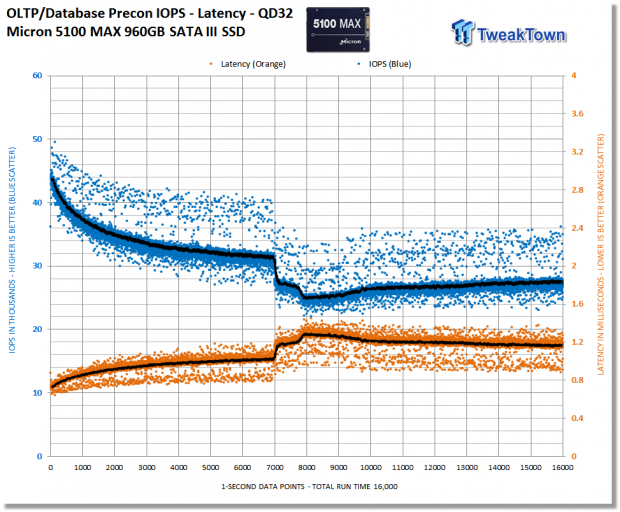
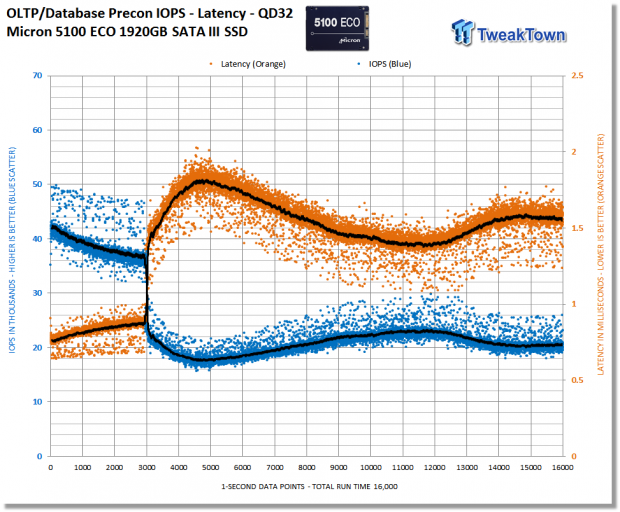
We precondition the drive for 16,000 seconds, or 4.44 hours, receiving performance data every second. We plot this data to observe the test subject's descent into steady-state. We plot both IOPS and Latency. We plot IOPS (represented by blue scatter) in thousands and Latency (represented by orange scatter) in milliseconds.
We observe steady-state for the 5100 MAX is reached at 14,000 seconds of preconditioning, settling in at about 27,000 IOPS at QD32. We note a significant number of outliers in the IO pattern. However, most of them are higher than the average, so that's a good thing. We observe steady-state for the 5100 ECO is reached at 15,000 seconds of preconditioning, settling in at about 20,500 IOPS at QD32.
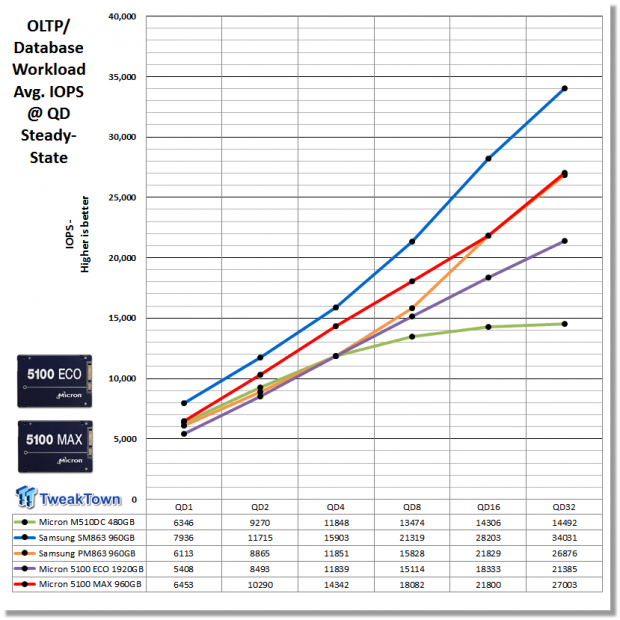
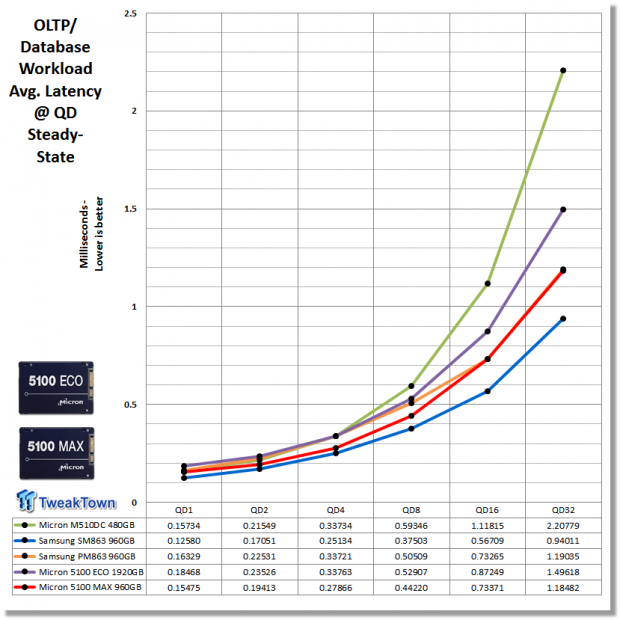
An On-Line Transaction Processing (OLTP) / Database workload is a demanding 8K test with a 66/33 percent R/W distribution. OLPT is online processing of financial transactions such as credit cards and high-frequency trading in the financial sector. Database workloads are challenging for any storage solution.
Database workloads have a greater mix of random read than an Email Server workload does, which is why the read-centric SM863 is able to distance itself from the 5100 MAX. The 5100 MAX does outperform the PM863 by a significant margin until we hit QD16, where they both perform equivalent to one another. The 5100 ECO brings up the rear at QD1-2. At QD4, the 5100 ECO, PM863, and the M510DC deliver similar performance. At queues above four, the 5100 ECO, PM863, and the M510DC part ways. At queues of 8 and higher, the PM863 performs better than the 5100 ECO. The 5100 ECO outperforms the M510DC by a significant margin at QD8 and higher.
Conclusion (TL;DR): Due to the write-centric nature of the 5100 series, the ECO and MAX are outperformed by their Samsung counterparts with a majority random read workload.
Mixed Workload Benchmarks - Web Server
Web Server
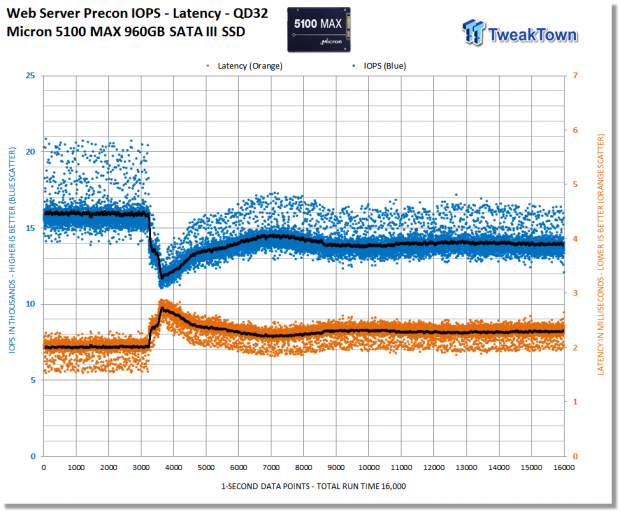
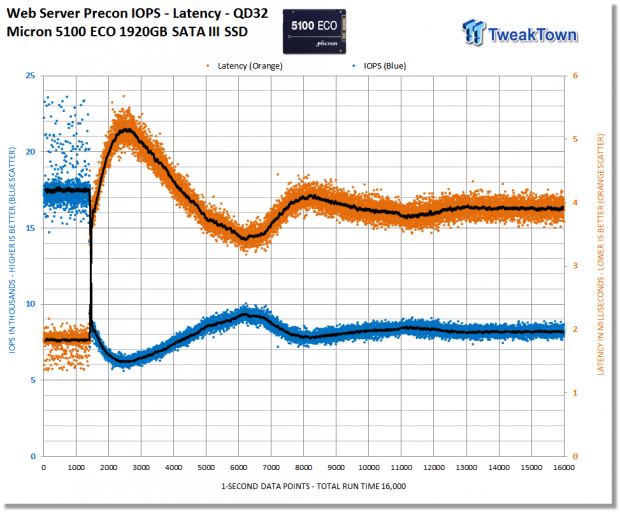
We precondition the drive for 16,000 seconds, or 4.44 hours, receiving performance data every second. We plot this data to observe the test subject's descent into steady-state. We plot both IOPS and Latency. We plot IOPS (represented by blue scatter) in thousands and Latency (represented by orange scatter) in milliseconds. We precondition with an inverted (all-write) workload.
We observe steady-state for the 5100 MAX is reached at 11,000 seconds of preconditioning, settling in at about 14,000 IOPS at QD32. We observe steady-state for the 5100 ECO is reached at 13,000 seconds of preconditioning, settling in at about 8,000 IOPS at QD32.
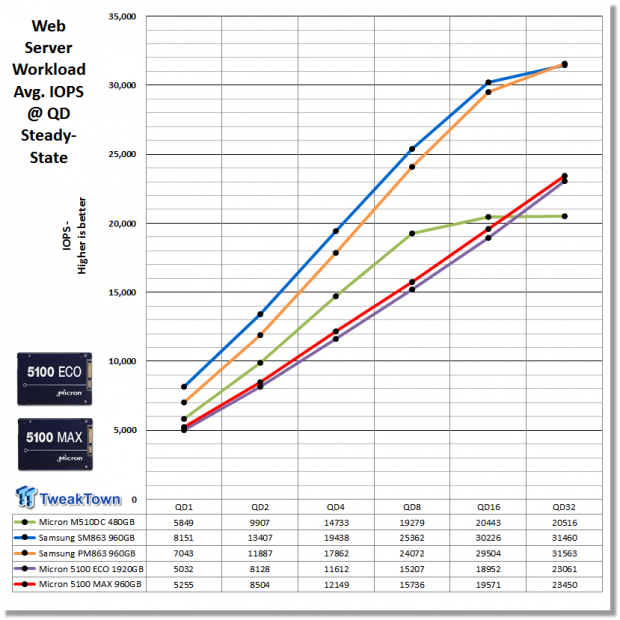
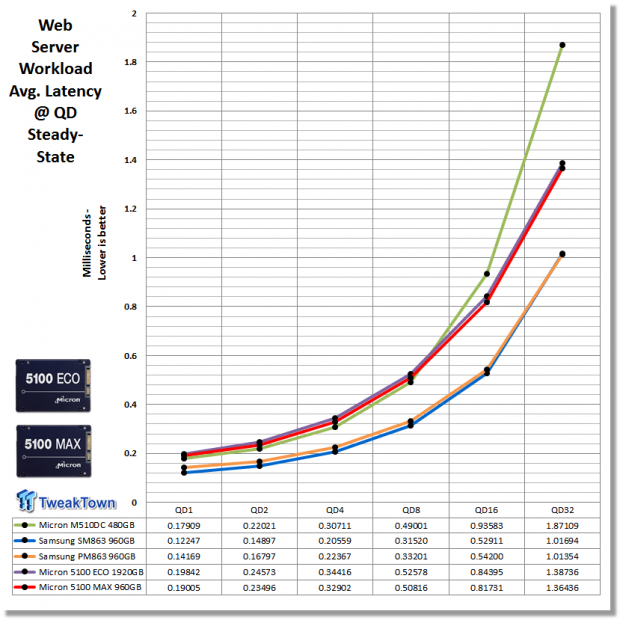
The Web Server workload is a pure random read test with a wide range of file sizes. Our test consists of the following file sizes and corresponding percentage of the overall 100 percent workload file size: 512B = 22 percent, 1KB = 15 percent, 2KB = 8 percent, 4KB = 23 percent, 8KB = 15 percent, 16KB = 2 percent, 32KB = 6 percent, 64KB = 7 percent, 128KB = 1 percent, and 512KB = 1 percent.
Although our Web mix does not represent a completely accurate modern web server workload, it is a very taxing workload that does give us a realistic representation of how well an SSD handles an all-read mix. An all random read workload is the arch nemesis of the write-centric 5100 series. There is no way to tune for this type of workload with Flex Cap because overprovisioning only has a positive effect on write performance. Even the M510DC outperforms the 5100 series at queue depths of up to 16. Conversely, the read-centric Samsung SM863 and PM863 flourish in this type of environment.
Conclusion (TL;DR): The 5100 Series is not provide class-leading performance in an all random read workload environment.
Final Thoughts
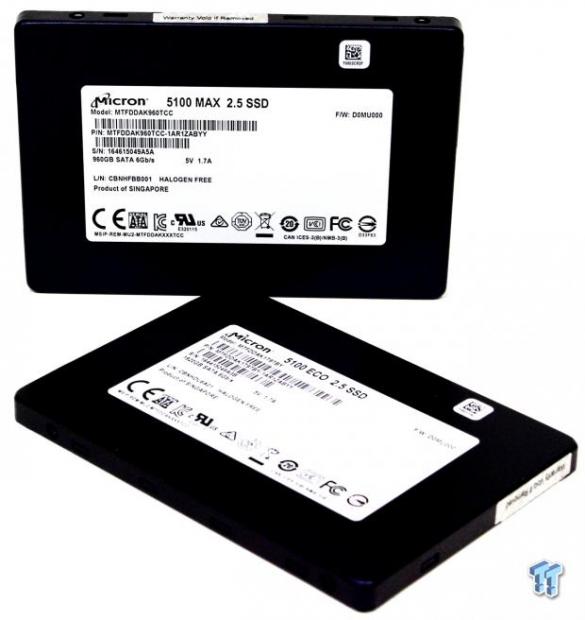
3D flash paves the way for better performance, greater density, and more endurance. Triple level cell architecture (TLC) in particular is the way forward because of its inherent lower production costs per gigabyte. So far, we have Samsung and Micron/Intel 3D flash in the market. Micron has the upper hand when it comes to cost, Samsung has the upper hand regarding overall performance. However, because Micron's 3D flash is so cost effective, they can counter Samsung with by offering enterprise SSDs with an overwhelming amount of over-provisioning built into their SSDs, which results in record-setting random write performance.
Micron's planar-based 9100 series gave us our first look at how throwing a bunch of flash into the mix can take random write performance to never before seen heights. The 5100 MAX follows along with this strategy; this time doing so with 3D TLC flash. Mass amounts of overprovisioning solve the two main problems inherent to TLC flash; write performance and endurance. Micron's enterprise-grade 3D eTLC flash takes it a step further when used in conjunction with a healthy dose of overprovisioning, by delivering write performance that either matches MLC flash or as in the case of the 5100 MAX, greatly exceeds anything we've seen to date.
Up until now, the highest 4K random steady-state write performance we've witnessed coming from a SATA SSD is about 28,000 IOPS and that is with MLC flash. Micron's eTLC-powered 960GB 5100 MAX shatters this mark delivering well over 79,000 IOPS, or 2.8X what others have been able to deliver to date. What makes this even more amazing is the fact that Micron is doing this with a 4-channel controller when others are using 8-channel controllers. The results of our mixed workload testing show that Micron's 5100 Series SSDs deliver performance that is as good as it gets when running workloads that have at least equivalent or majority random writes in the mix.
We are also very much excited by Micron's revolutionary FlexPro architecture. This architecture allows users to actively tune the write performance and endurance of Micron SSDs to fit their specific needs. Just look at what were able to do with the 5100 ECO; we tripled the drives 4K random write performance by using Micron's FlexCap feature to increase the drives over-provisioning at the hardware level. This means you can easily repurpose any drive in the 5100 series to handle evolving applications in the most efficient manner possible.
Spinning media is winding down and the time is now to move on from legacy media and make the datacenter agile and efficient with all-flash arrays. Micron's 5100 series SSDs dramatically lower TCO in comparison to traditional datacenter solutions. In the end, it all comes down to one thing; TCO per IO.
Micron's 5100 Max and 5100 ECO deliver the goods in a manner that makes them both worthy of TweakTown's Editor's Choice Award.
Pros:
- Low Cost
- Random Write Performance
- Endurance
- Flexability
Cons:
- Pure Random Read Mixed Performance

| Performance | 95% |
| Performance Consistency | 90% |
| General Features | 98% |
| Value for Money | 95% |
| Quality, Design, Build, and Warranty | 99% |
| Overall | 95% |
The Bottom Line: The dominating write performance of the 5100 MAX and the versatility of the 5100 ECO combined with FlexCap earn the Micron 5100 series SSDs our Editor's Choice award.
PRICING: You can find products similar to this one for sale below.
 United
States: Find other tech and computer products like this
over at Amazon.com
United
States: Find other tech and computer products like this
over at Amazon.com
 United
Kingdom: Find other tech and computer products like this
over at Amazon.co.uk
United
Kingdom: Find other tech and computer products like this
over at Amazon.co.uk
 Australia:
Find other tech and computer products like this over at Amazon.com.au
Australia:
Find other tech and computer products like this over at Amazon.com.au
 Canada:
Find other tech and computer products like this over at Amazon.ca
Canada:
Find other tech and computer products like this over at Amazon.ca
 Deutschland:
Finde andere Technik- und Computerprodukte wie dieses auf Amazon.de
Deutschland:
Finde andere Technik- und Computerprodukte wie dieses auf Amazon.de
What's in Jon's PC?
- CPU: AMD Ryzen 7800X 3D
- MOTHERBOARD: GIGABYTE AORUS Master X670E
- RAM: Kingston Fury Renegade 7200MHz 32GB
- GPU: ZOTAC AMP Extreme GeForce RTX 4090
- SSD: Crucial T700 2TB Gen5
- OS: Windows 11 Pro
- COOLER: Lian Li Galahad 360 AIO
- CASE: Lian Li Lancool III
- KEYBOARD: Corsair K65 RGB Mini
- MOUSE: SteelSeries AEROX 5 Wireless
- MONITOR: ASUS ROG Strix PG27AQN 360Hz 1440p ULMB2
Similar Content
Related Tags

